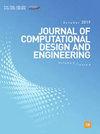基于元启发式算法的疫苗分配状态依赖M/M/1队列位置分配模型
IF 6.1
2区 工程技术
Q1 COMPUTER SCIENCE, INTERDISCIPLINARY APPLICATIONS
引用次数: 2
摘要
在疾病面前控制和维护公共卫生需要有效执行应对战略,包括分发疫苗。通过分发疫苗,可以针对脆弱人群,保护个人,并最大限度地减少疾病的传播。然而,管理疫苗分发带来了挑战,需要仔细考虑各种因素,包括分发设施的位置。本文提出了一种将位置分配问题与排队系统方法相结合的新模型,以优化疫苗分配效率。该模型考虑了需求不确定、服务费率随系统状态变化等因素。它的主要目标是最小化总成本,这包括服务机制的建立和调整、旅行时间和客户等待时间。为了预测客户需求率,该模型利用时间序列技术,特别是季节性自回归综合移动平均(ARIMA)模型。为了解决大规模问题,总共采用了16种新开发的元启发式算法,并对它们的性能进行了全面评估。这种方法有助于在合理的时间范围内生成几乎最优的解决方案。通过对伊朗疫苗接种分布的真实案例研究,评估了该模型的有效性。此外,还进行了综合敏感性分析,以验证该模型的实际适用性。该研究有助于推进健全的决策框架,并为解决卫生系统中与地点有关的挑战提供宝贵见解。本文章由计算机程序翻译,如有差异,请以英文原文为准。
A state-dependent M/M/1 queueing location-allocation model for vaccine distribution using metaheuristic algorithms
Controlling and maintaining public health in the face of diseases necessitates the effective implementation of response strategies, including the distribution of vaccines. By distributing vaccines, vulnerable populations can be targeted, individuals can be protected, and the spread of diseases can be minimized. However, managing vaccine distribution poses challenges that require careful consideration of various factors, including the location of distribution facilities. This paper proposes a novel model that combines location-allocation problems with queueing systems methodologies to optimize the efficiency of vaccine distribution. The proposed model considers factors such as uncertain demand, varying service rates, depending on the system state. Its primary objective is to minimize total costs, which encompass the establishment and adjustment of the service mechanism, travel times, and customer waiting time. To forecast customer demand rates, the model utilizes time series techniques, specifically the seasonal Autoregressive Integrated Moving Average (ARIMA) model. In order to tackle large-scale problems, a total of 16 newly developed Metaheuristic algorithms are employed, and their performance is thoroughly evaluated. This approach facilitates the generation of solutions that are nearly optimal within a reasonable timeframe. The effectiveness of the model is evaluated through a real case study focused on vaccination distribution in Iran. Furthermore, a comprehensive sensitivity analysis is conducted to demonstrate the practical applicability of the proposed model. The study contributes to the advancement of robust decision-making frameworks and provides valuable insights for addressing location-related challenges in health systems.
求助全文
通过发布文献求助,成功后即可免费获取论文全文。
去求助
来源期刊

Journal of Computational Design and Engineering
Computer Science-Human-Computer Interaction
CiteScore
7.70
自引率
20.40%
发文量
125
期刊介绍:
Journal of Computational Design and Engineering is an international journal that aims to provide academia and industry with a venue for rapid publication of research papers reporting innovative computational methods and applications to achieve a major breakthrough, practical improvements, and bold new research directions within a wide range of design and engineering:
• Theory and its progress in computational advancement for design and engineering
• Development of computational framework to support large scale design and engineering
• Interaction issues among human, designed artifacts, and systems
• Knowledge-intensive technologies for intelligent and sustainable systems
• Emerging technology and convergence of technology fields presented with convincing design examples
• Educational issues for academia, practitioners, and future generation
• Proposal on new research directions as well as survey and retrospectives on mature field.
 求助内容:
求助内容: 应助结果提醒方式:
应助结果提醒方式:


